JoWonder, born Joanna Woodward, is a writer, animator, visual artist and performer. Her work creates a magical irony stolen from myth and tradition in folklore, literature and painting. Her work is informed by a background in the discipline of animation. She talks to Jan Woolf.
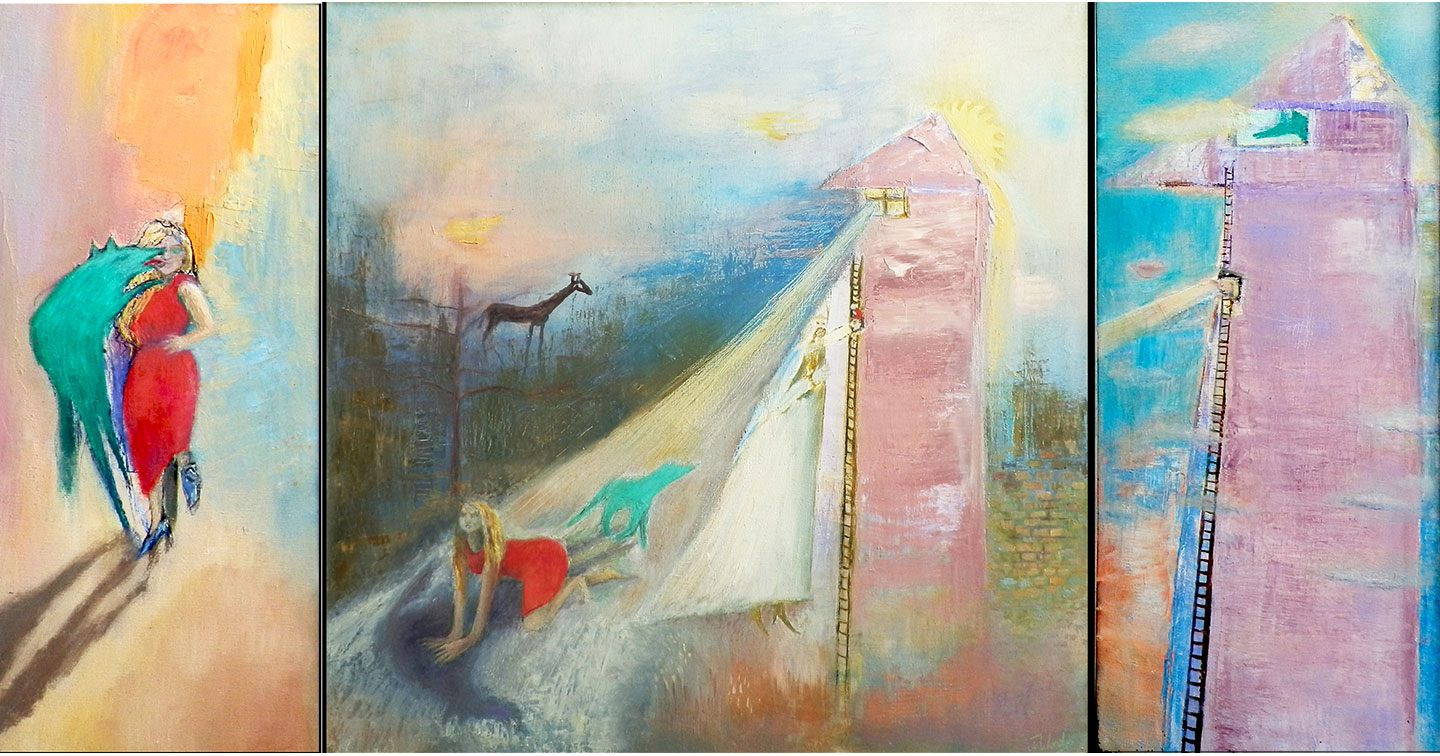
‘Green Wolf’ , oils on canvas tryptich in wood box, 50.8 x 88.9cm (also close ups)
JoWonder – Yes, of course past traditions interest me. Today, we have an enormous flow of images from the internet, but the artists of the past have a sensibility that’s impossible to ignore.
I’m an admirer of Cecil Collins, he talked about there being “two main groups of artists, the ones who are painting a decay, the end of a civilisation … and those, perhaps very few … who sense the beginnings of a new civilisation.” I don’t think much has changed since then, and I’m in the latter group. For me the artists’ role is not to provide more cynicism, there is an excess of that, I want to create order out of chaos, meaning from the absurd.
As well as Collins, I greatly admire the Expressionists and their use of colour: Emil Nolde is a particular favourite, he mentioned seeking to inspire “awe,” – something which I think is very valuable.
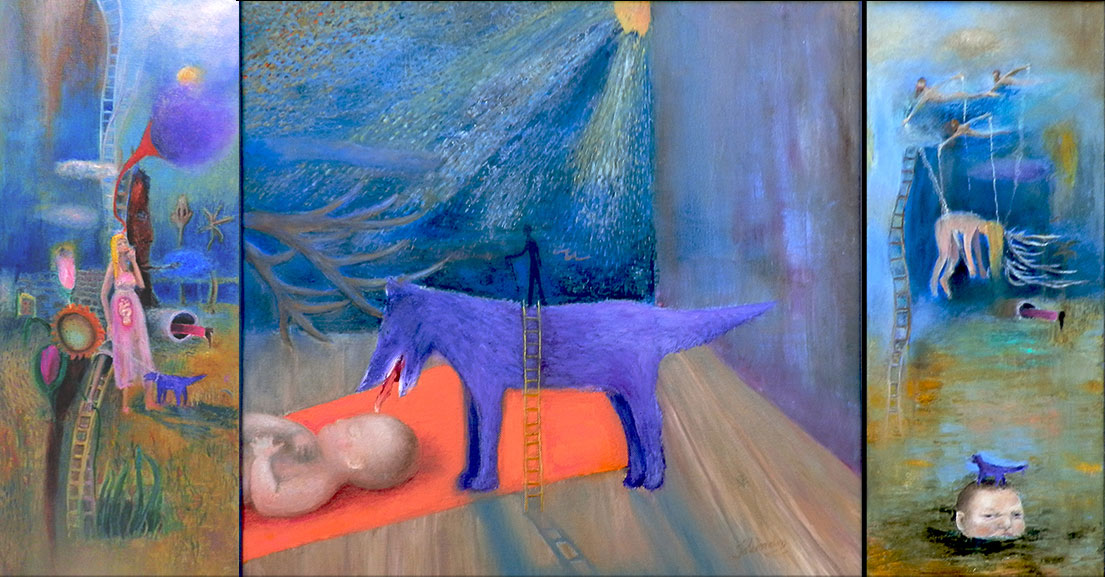
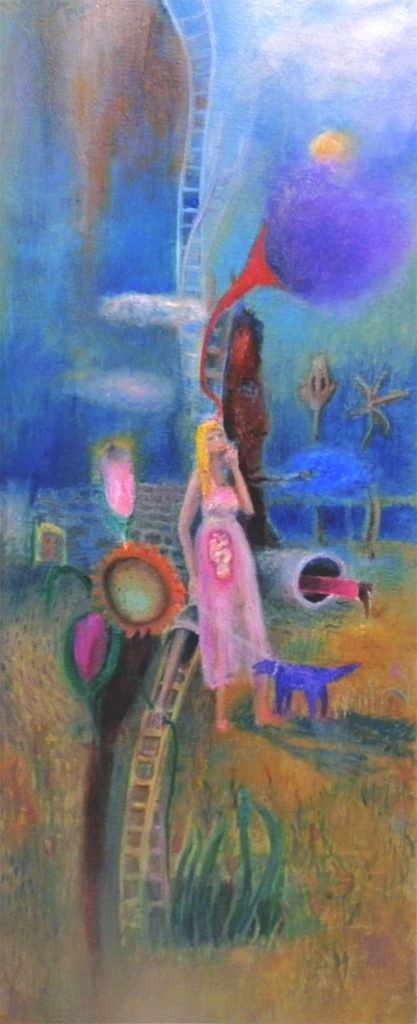
‘Dog Licks Baby’, oils on canvas tryptich in wood box, 50.8 x 91.44cm. (Also close up)
Some of my influences come from my education in the discipline and history of animation. I particularly admire the Soviet Russian animators, especially the work they did before Perestroika. They didn’t even know if the films that they made were going to be seen, but their work contained a gallant sense of hope. For example: in Yuri Norstein’s animated film Tale Of Tales, the subject was taken from the artist’s childhood memories, and he managed to touch on the horrors of The Second World War, through the gentle and poetic eyes of an innocent wolf.
Blake’s ‘Ghost of a Flea’ is a miniature painting only (21.4 × 16.2 cm), but it’s monumental in its imagination. I like the secrecy and humility small work embodies, that combined with its humour creates a fantastic counterpoint to the pomposity prevalent in the art world. Pictures like this will never become dated, because their wit is timeless.
Best of all, I love Marc Chagall, for his divine vision. For example in his painting ‘Over Vitebsk,’ he depicts a beggar moving from door to door, but the character is airborne, imbuing the composition with a dreamlike otherworldliness, providing hope and desperately needed optimism, in what would otherwise be a dismal scene.
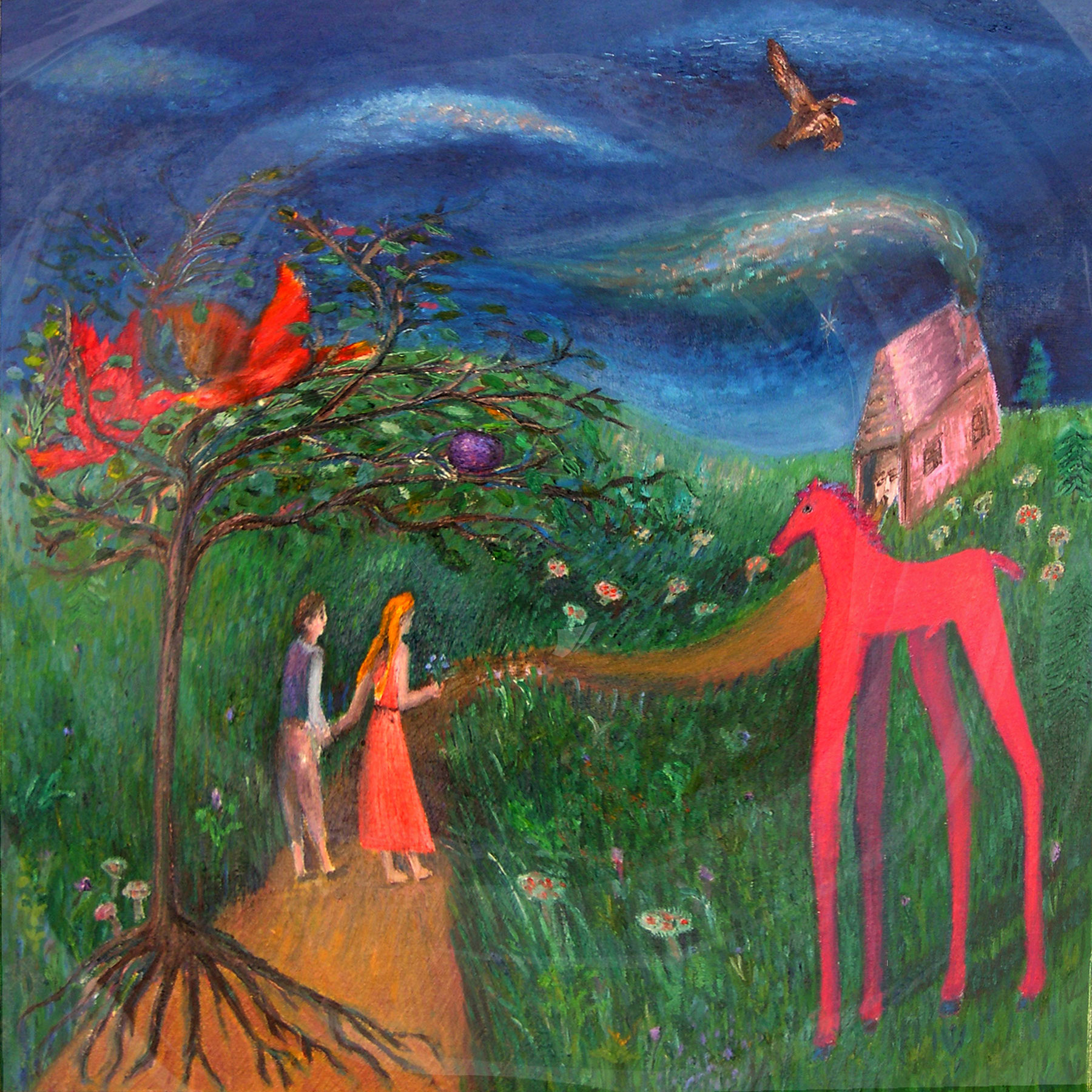
‘The Path’, miniature print, 15.24 x 15.24cm
The work of these artists embody an exemplary playfulness and an intimacy born of hand crafting that unmasks a touching vulnerability that I believe is a part of all human nature.
I’m definitely influenced by spending my early years at a school based inside a convent. Christianity is full of allegorical narrative. In the convent art was seen as something supernatural. In contrast at home the only purpose of art was to match the furnishing, which made me sad. At school a dove above the head of someone being baptized, was more than just a bird, it was a symbol that something miraculous was going to happen, and I still believe in miracles today.
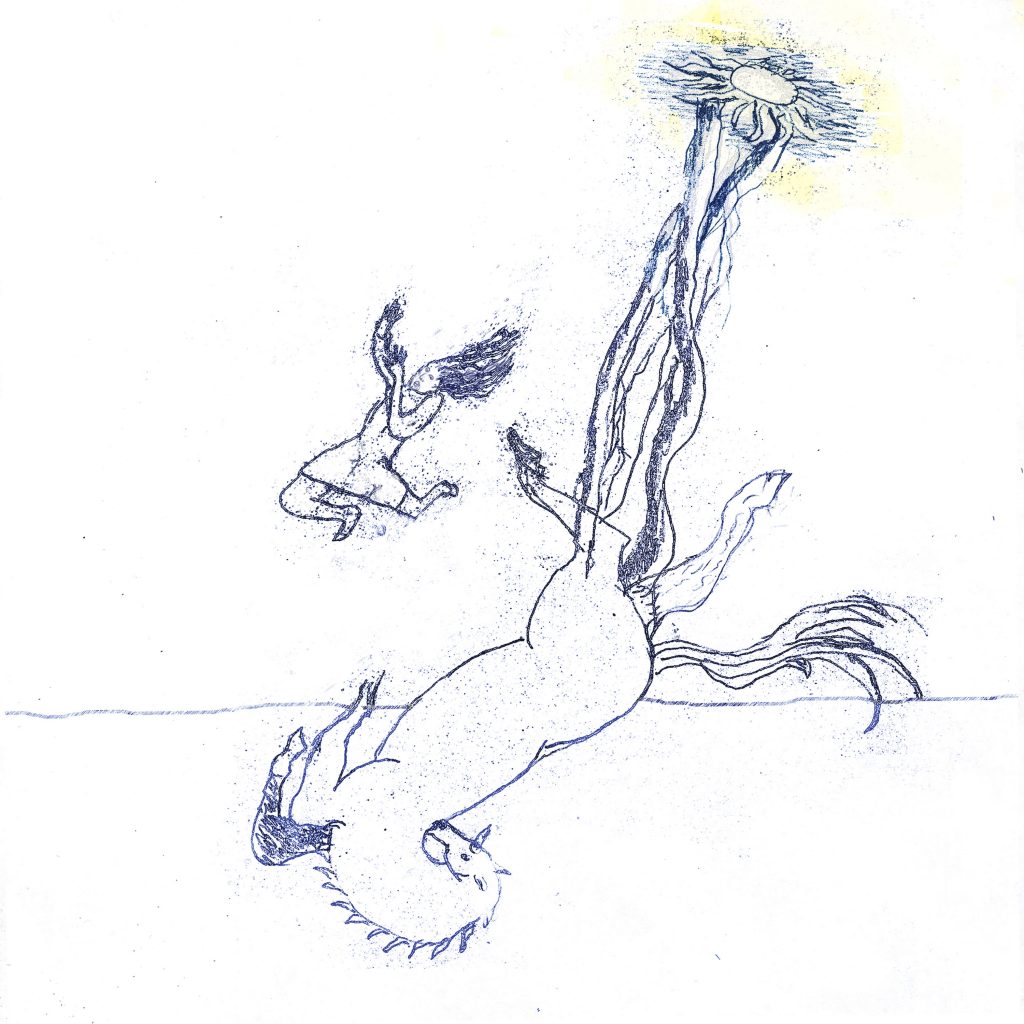
‘Miracle’, pencil drawing on paper 21 x 29.7cm
Jan Woolf – Can I ask about the animation. I think these are charming and funny – but with a darkness to them. How do you know when an idea is best served as a painting or as animation?
JoWonder – It’s the theatrical illusion that appeals to me in animation and I prefer the hand crafted look of stop frame animation. Animation is a place where you can sculpt time, it’s a great way to present fresh ideas about the delusion of linear time. I made an installation called ‘Flatlanders’ using animation which was about the nuclear experiment at CERN, the Centre For Nuclear Research, where they were attempting to create the environment that existed at the beginning of time. In it I referenced Bruegel’s painting, The Fall Of Icarus, as I thought that something quite miraculous was going on at CERN. I depicted an Icarus both flying to the sun and losing his wings and also an Icarus who experienced the process in reverse and flew to the sun and was embellished with wings. Moving image and multiple images help us hold paradoxical ideas together.
Using distortion of time can also help to re- invent a world where psychological defeat gets turned into victory, death can be transformed into birth. A mirror of our own world can be made with all its darkness and disappointment, but where there would nevertheless be a satisfying conclusion or beauty to be found. I made a painting in bacteria which made reference to John Millais’ Ophelia, here the painting is eaten and destroyed by the new life of the bacteria.
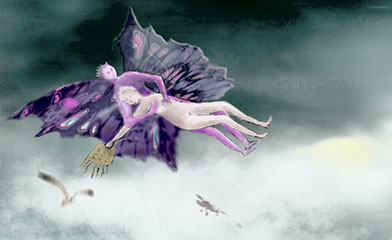
‘Miniature print’ Lucky Number 8.89 x 12.7cm
If I can’t make animated films, I put distorting lenses in front of oil paintings, so that they distort like a hallucinatory fantasy with every move of the head, or I make three images into a triptych; showing a series of connected pictures that reach a satisfying conclusion. Like the use of ‘Milagros:’ a folk custom designed to tell a story in symbolic images to focus the mind, or even create a miracle. I would like to make more animations, but they can take up to three years or longer to make and there’s little money around these days for such things.
In the narratives of the future, that will most likely be multi-trajectory and incorporate virtual reality; the desire for the look of the hand crafted as well as the need to turn psychological defeat into victory, will I’m sure prevail because it’s a basic human need.
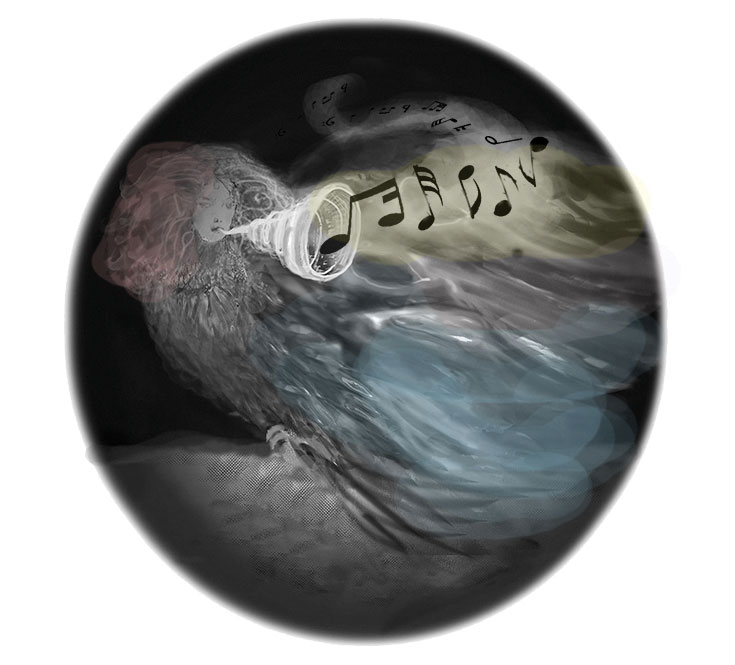
‘Trumpet-Bird’, miniature Print, 17.78 cm
Jan – Many of your magical creatures seem to be asking something of us. I think it was Foucault who said that animals have huge resonance for us – not just as food. Say something about your animals- particularly the unicorn.
Jo – The most important thing about animals for me is that they don’t talk. This gives them a mystery, and pictorially they seem more malleable than people; a simple exaggeration of their form or gesture, can transform them from tame to primal.
I made a painting which became a triptych, called ‘Green Wolf,’ it shows a green wolf in the left panel kissing a woman in a bright red dress, the wolf is like the raw inner workings of the mind, but in the final panel the same wolf is small and insignificant- tamed, like a little Rapunzel locked in a tower. In a triptych like this, the advantage is that all three postures of the creature can be observed at once.
I made another triptych with a purple dog called, ‘Dog Licks Baby’, here the dog is more like a domesticated wolf: in the first picture it’s seen on a lead, but in the other pictures, when it’s set free, it has supernatural powers of friendship and healing.
The humility of horses fascinates me. Humility is a source of strength, but one that can and is exploited. I see unicorns as horses recognised for a possession of magic powers of insight. Unrecognised they are sad creatures who are exploited and repressed. I’m just completing an illustrated story that includes unicorns that are exploited- its very sinister- they’re hung upside down and made to operate the mechanism of a clock!
In my reading of this story, the unicorns are made of paper and pop up out of a book where they have been waiting patiently to be set free. The idea here is that: via the ritual of the performance, the unicorns can finally be seen and therefore set free.

‘The Unicorn Trumpet’, book Art work with decoupage unicorns, 49x 95cm
Jan – You’re good at synthesising and coming up with something completely new. I loved that bit in your story reading where you took a cut out horn from your book – and blew it to recorded sound. This was magical. It seems that these ideas bypass the mind and come from somewhere else. Can you comment on that?
Jo – During the telling of a story the audience has to suspend their disbelief, I think it’s just as important for adults as it is for children to imagine the unimaginable. I would hope to inspire a childish sense of play, like the experience of transforming a paper bag into a hat.
I wanted to captivate the audience by using real objects that, however insubstantial, had more presence than the ‘none-reality’ of the digital images projected during the performance.
It’s the sound of the paper horn that conjures up the pop-up unicorns. I play with what at first appears to be an irrational, illogical idea: a paper horn being able to make a grand sound.
Below link to performance, at the Phoenix Art Gallery, Brighton, 2016:
Jan – There can be a childlike element in your work. You’ve used the expression ‘Teddies for grown ups.’ So a lot of your work reaches back into some of the stories we heard as children, and further back into our psyches. I’m interested in Bruno Bettelheim’s book ‘The Uses of Enchantment’ – where he writes about our projections into fairy stories as a way of problem solving. That this is part of our maturation process. I would say your work has this element too. Do you?
Jo -Yes, they say that fairy stories stories help children grapple with darkness, abandonment and death, but adults need to grapple with this too, and scepticism is too blunt a tool to dig below the surface of things like this; this is why I think fairy stories are so important.
The need for story-telling didn’t leave us when we grew up, it only took on new guises. In our culture, scientists and the manipulators of the media may appear to be the purveyors of truth, but it is still to stories, films and novels, that we turn for a more poignant version of reality.
What interests me as a visual artist, as much as a storyteller, is not a harsh representation of reality or an abstraction from it, but the strength and persistence of those that inhabit the fantasy landscapes of fairy stories: here the unicorns, birds and horses face the formidable with gallant resignation, for they are at the mercy of fate. But surely at the same time they are aware that they are figments of our imagination? These silent heroes stare back at us knowingly – like button-eyed teddies. We too are at the mercy of fate, which as well as being a damnation can also be a wonderment.
Interview by: Jan Woolf
Artists Web Site: http://jowonder.com/
JoWonder – a brief curriculum vitae
Her films are included in the BFI Collection, and The World History Of Animation Volume 111.
April 2016- reading from the illustrated story ‘Ziggy Starlight with animation.’ The Technology and the Evolution of the Artist’s Book, Brighton, Uk.
2015-Solo show of print Brighton Buddhist centre, Uk,
2015- Redland Museum Cleveland Australia, Personal Histories international Book Art Exhibition
2014 & 2015. ‘Don’t Submit To A Moments Passion With A Stranger,’ a part of ‘T1+2 Gallery Annex Projects,’ London.
2013-animated video installation ‘Flatlanders’ commissioned as a part of a science debate about CERN (Centre European For Nuclear Research) shown Guildford Cathedral, Uk. Also Washington Dc Arts Centre, USA. Fresh Abstractions Film Festival, SF World, Bangkok.
2013-Solo show of paintings at ‘The Other Gallery,’ London.
2012 to present, Wellcome Trust Project, ‘Six Days Goodbye Poems of Ophelia’, animated painting in bacteria representing John Millais Ophelia. Shown in the Wellcome Trust Gallery. The project can be viewed and also receive new poetry contributions at:
2012 Performance: ‘JoWonder and the Psychic Tea Leaves,’ in the belfry at The Church of St John, London, (rated as a top 5 First Thursdays by The Whitechapel Art Gallery. (Also)The Gatehouse Theatre, Harlow, and the Courtyard Theatre, London(2011).
2010- invited by writer and mythographer Marina Warner to perform at a fairy tale masked ball organised by The Last Tuesday Society.
2011-solo show of paintings at AQFFIN Gallery, London.
2008- On meeting Peter Blue, who focuses on web-based projects, set up British Women Artists as a means to extend the boundaries of what was perceived as important and of historic notability, with the ultimate goal to build an on line archive of Contemporary Women artists who are mostly not represented by galleries..
2000-2006- Artists residencies: The First Station, Bromley By Bow, London (1998-2000)and Lewisham College.
1996-mixed animation and live action film animated Film, ‘The Weatherhouse’, written and directed commissioned by BBC2.
1994- mixed animation and live action film ,’Sawdust For Brains And The Key Of Wisdom’, was written directed and written by the artist, commissioned by Channel 4 Television. See link to film:
1990- mixed animation and live action film, ‘The Brooch Pin And The Sinful Clasp’ won the grand prix Zagreb International Film Festival, Time Out Film Award and Best Newcomer at Cardiff Animation Festival. (The film features the renowned performance artist Rose English).

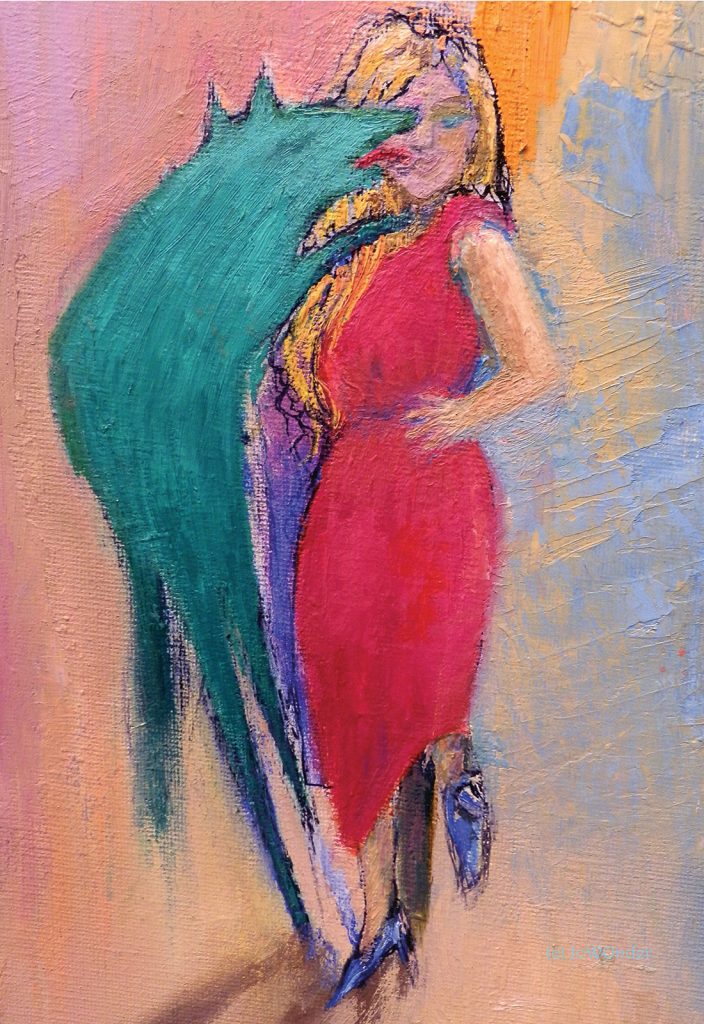
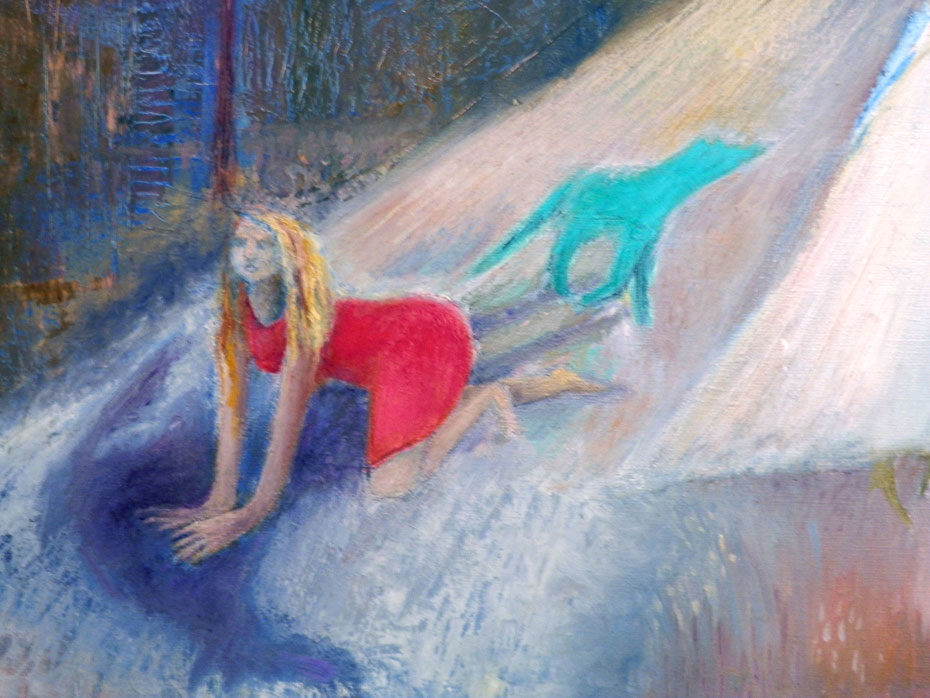
Thanks for this introduction to a wonderful artist. A fine description of a sensibility missing today from art-as-we-are-told-it-is. I.T is certainly back on the case!
Comment by Cy Lester on 25 October, 2016 at 9:50 am